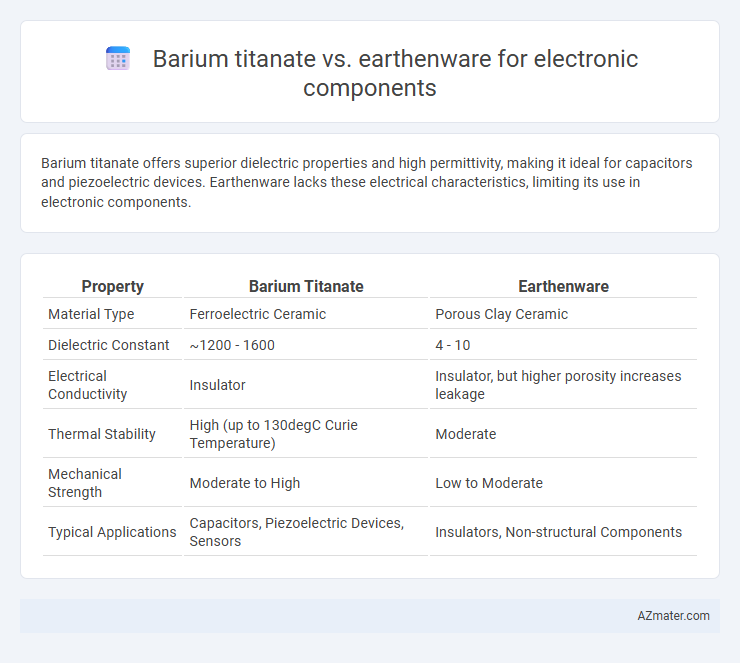Barium titanate offers superior dielectric properties and high permittivity, making it ideal for capacitors and piezoelectric devices. Earthenware lacks these electrical characteristics, limiting its use in electronic components.
Table of Comparison
| Property | Barium Titanate | Earthenware |
|---|---|---|
| Material Type | Ferroelectric Ceramic | Porous Clay Ceramic |
| Dielectric Constant | ~1200 - 1600 | 4 - 10 |
| Electrical Conductivity | Insulator | Insulator, but higher porosity increases leakage |
| Thermal Stability | High (up to 130degC Curie Temperature) | Moderate |
| Mechanical Strength | Moderate to High | Low to Moderate |
| Typical Applications | Capacitors, Piezoelectric Devices, Sensors | Insulators, Non-structural Components |
Introduction to Barium Titanate and Earthenware
Barium titanate is a ferroelectric ceramic material widely used in electronic components such as capacitors, sensors, and actuators due to its high dielectric constant and excellent piezoelectric properties. Earthenware, a porous ceramic made from natural clay, is traditionally used for insulation but lacks the specialized electrical characteristics required for modern electronic applications. The stark contrast in electrical performance and material composition defines barium titanate as a superior choice in advanced electronic component manufacturing compared to earthenware.
Composition and Material Properties
Barium titanate, a ceramic compound composed of barium, titanium, and oxygen, exhibits high dielectric constants and excellent ferroelectric properties, making it ideal for capacitors and multilayer ceramic devices. Earthenware, primarily consisting of clay, silica, and feldspar, lacks the specific dielectric and piezoelectric properties required for advanced electronic components, resulting in lower electrical insulation and mechanical stability. The superior permittivity and temperature stability of barium titanate significantly outperform the porous, structurally weaker nature of earthenware in electronic applications.
Dielectric Performance Comparison
Barium titanate exhibits significantly higher dielectric constant values, often exceeding 1000, compared to earthenware materials, which typically have dielectric constants below 10, making barium titanate far superior for high-performance electronic components requiring efficient energy storage and insulation. Its low dielectric loss and high permittivity enable enhanced capacitive behavior and stability under varying frequencies and temperatures, whereas earthenware's natural composition leads to inconsistent dielectric properties and higher loss tangents. The superior dielectric breakdown strength of barium titanate further ensures reliability and durability in advanced electronic applications, outperforming the more porous and less uniform structure of earthenware ceramics.
Electrical Conductivity and Insulation
Barium titanate exhibits high dielectric permittivity and excellent electrical insulation, making it ideal for capacitors and piezoelectric devices due to its strong ferroelectric properties. Earthenware, composed mainly of porous clay, has comparatively low electrical conductivity and weaker insulation capabilities, limiting its use in electronic components. The superior electrical insulation and tunable conductivity of barium titanate make it a preferred material over earthenware in high-performance electronic applications.
Manufacturing Processes and Scalability
Barium titanate's manufacturing involves complex ceramic sintering and high-temperature processing to achieve its piezoelectric properties, enabling precise control but requiring specialized facilities. Earthenware uses traditional clay molding and kiln firing, offering lower production costs and easier scalability but limited electronic performance due to its non-piezoelectric nature. Scalability favors earthenware for mass production due to simpler processes, while barium titanate suits high-performance components demanding strict quality control and material purity.
Thermal Stability and Durability
Barium titanate exhibits superior thermal stability compared to earthenware, maintaining consistent dielectric properties at high temperatures essential for electronic components. Its robustness under thermal cycling enhances durability, reducing the risk of cracking or performance degradation. In contrast, earthenware's porous structure leads to lower thermal stability and susceptibility to mechanical wear, limiting its effectiveness in demanding electronic applications.
Applications in Electronic Components
Barium titanate is widely used in electronic components such as multilayer ceramic capacitors (MLCCs) and piezoelectric devices due to its high dielectric constant and excellent ferroelectric properties, enabling efficient energy storage and signal processing. Earthenware, primarily composed of clay, lacks the necessary electrical properties and thermal stability, making it unsuitable for advanced electronic applications but occasionally used as insulating materials in low-cost, non-critical parts. The superior dielectric performance and reliability of barium titanate make it a preferred material in sensors, actuators, and capacitors within the electronics industry.
Cost Effectiveness and Availability
Barium titanate offers superior dielectric properties essential for high-performance electronic components but is generally more expensive and less readily available compared to earthenware ceramics. Earthenware is cost-effective and widely accessible, making it suitable for low-cost, non-critical electronic applications despite its lower dielectric constant and stability. Manufacturers prioritize barium titanate when performance and miniaturization outweigh cost, whereas earthenware serves as a budget alternative with more abundant supply chains.
Environmental Impact and Sustainability
Barium titanate, a lead-free ceramic material widely used in capacitors and sensors, offers a lower environmental impact due to its high dielectric constant and enhanced energy efficiency, reducing electronic waste through durability and performance. Earthenware, composed mainly of natural clay, has less complex manufacturing processes but suffers from higher brittleness and lower electrical efficiency, leading to shorter component lifespans and increased disposal rates contributing to environmental strain. Sustainable electronics benefit more from barium titanate's recyclability and reduced reliance on scarce raw materials compared to the larger ecological footprint of earthenware-based components.
Conclusion: Choosing the Optimal Material
Barium titanate exhibits superior dielectric properties, high permittivity, and excellent temperature stability, making it ideal for capacitors and piezoelectric components in electronic applications. Earthenware, while cost-effective and easy to manufacture, lacks the precision and performance characteristics necessary for advanced electronic components. Selecting barium titanate ensures enhanced efficiency and reliability in electronic devices, outperforming earthenware in key functional parameters.

Infographic: Barium titanate vs Earthenware for Electronic component
 azmater.com
azmater.com